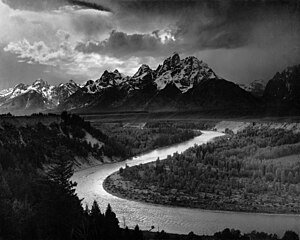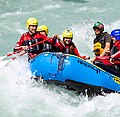| Portal | WikiProject Rivers | Talk page |
Introduction

A river is a natural freshwater stream that flows on land or inside caves towards another body of water at a lower elevation, such as an ocean, lake, or another river. A river may run dry before reaching the end of its course if it runs out of water, or only flow during certain seasons. Rivers are regulated by the water cycle, the processes by which water moves around the Earth. Water first enters rivers through precipitation, whether from the runoff of water down a slope, the melting of glaciers or snow, or seepage from aquifers beneath the surface of the Earth.
Rivers flow and merge in confluences to form drainage basins, areas where all water eventually flows to a common outlet. Rivers have a great effect on the landscape around them. They may regularly overflow their banks and flood the surrounding area, spreading nutrients to the surrounding area. Sediment or alluvium carried by rivers shapes the landscape around it, forming deltas and islands where the flow slows down. Rivers rarely run in a straight line, instead, they bend or meander; the locations of a river's banks can change frequently. Rivers get their alluvium from erosion, which carves rock into canyons and valleys.
Rivers have sustained human and animal life for millennia, including the first human civilizations. The organisms that live around or in a river such as fish, aquatic plants, and insects have different roles, including processing organic matter and predation. Rivers have produced abundant resources for humans, including food, transportation, drinking water, and recreation. Humans have engineered rivers to prevent flooding, irrigate crops, perform work with water wheels, and produce hydroelectricity from dams. People associate rivers with life and fertility and have strong religious, political, social, and mythological attachments to them. (Full article...)
Selected article -
White Deer Hole Creek is a 20.5-mile (33.0 km) tributary of the West Branch Susquehanna River in Clinton, Lycoming and Union counties in the U.S. state of Pennsylvania. A part of the Chesapeake Bay drainage basin, the White Deer Hole Creek watershed drains parts of ten townships. The creek flows east in a valley of the Ridge-and-valley Appalachians, through sandstone, limestone, and shale from the Ordovician, Silurian, and Devonian periods.
As of 2006, the creek and its 67.2-square-mile (174 km2) watershed are relatively undeveloped, with 28.4 percent of the watershed given to agriculture and 71.6 percent covered by forest, including part of Tiadaghton State Forest. The western part of White Deer Hole Creek has very high water quality and is the only major creek section in Lycoming County classified as Class A Wild Trout Waters, defined by the Pennsylvania Fish and Boat Commission as "streams which support a population of naturally produced trout of sufficient size and abundance to support a long-term and rewarding sport fishery." The rest of the creek and its major tributary (Spring Creek) are kept stocked. There are opportunities in the watershed for canoeing, hunting, and camping, and trails for hiking and horseback riding. (Full article...)Selected Quote
Selected picture

The Tetons and the Snake River (1942)
General images -
Did you know?
- ... that 25 million tourists—more than twice the population of the entire state—visited the Mandakini River in Uttarakhand in 2011?
- ... that for three years, an illegal gold-mining settlement on the Amur river went on to host high-class hotels, have public healthcare, and even have a casino?
- ... that Boom Hall was named after a defensive structure on the River Foyle that was breached during the 1689 Siege of Derry?
Related portals
Selected Panorama
Topics
Subcategories
Quality content
| This is a list of recognized content, updated weekly by JL-Bot (talk · contribs) (typically on Saturdays). There is no need to edit the list yourself. If an article is missing from the list, make sure it is tagged (e.g. {{WikiProject Rivers}}) or categorized correctly and wait for the next update. See WP:RECOG for configuration options. |
Featured articles
 Aliso Creek (Orange County)
Aliso Creek (Orange County) Balch Creek
Balch Creek Big Butte Creek
Big Butte Creek Bull Run River (Oregon)
Bull Run River (Oregon) Chetco River
Chetco River Colorado River
Colorado River Columbia River
Columbia River Columbia Slough
Columbia Slough Fanno Creek
Fanno Creek Johnson Creek (Willamette River tributary)
Johnson Creek (Willamette River tributary) Jordan River (Utah)
Jordan River (Utah) Little Butte Creek
Little Butte Creek Plunketts Creek (Loyalsock Creek tributary)
Plunketts Creek (Loyalsock Creek tributary) River Parrett
River Parrett Rogue River (Oregon)
Rogue River (Oregon) St. Johns River
St. Johns River Tryon Creek
Tryon Creek Waterfalls in Ricketts Glen State Park
Waterfalls in Ricketts Glen State Park White Deer Hole Creek
White Deer Hole Creek Willamette River
Willamette River
Featured lists
 List of longest rivers of the United States (by main stem)
List of longest rivers of the United States (by main stem) List of longest streams of Idaho
List of longest streams of Idaho List of longest streams of Oregon
List of longest streams of Oregon List of tributaries of Bowman Creek
List of tributaries of Bowman Creek List of tributaries of Catawissa Creek
List of tributaries of Catawissa Creek List of tributaries of Larrys Creek
List of tributaries of Larrys Creek List of tributaries of Mahanoy Creek
List of tributaries of Mahanoy Creek List of tributaries of Shamokin Creek
List of tributaries of Shamokin Creek
Good articles
 1886 St. Croix River log jam
1886 St. Croix River log jam Abrahams Creek
Abrahams Creek Adams River (British Columbia)
Adams River (British Columbia) River Avon, Bristol
River Avon, Bristol Big Wapwallopen Creek
Big Wapwallopen Creek Black Creek (Susquehanna River tributary)
Black Creek (Susquehanna River tributary) Briar Creek (Susquehanna River tributary)
Briar Creek (Susquehanna River tributary) Brunswick Falls
Brunswick Falls Buffalo Creek (West Branch Susquehanna River tributary)
Buffalo Creek (West Branch Susquehanna River tributary) Canajoharie Creek
Canajoharie Creek Catawissa Creek
Catawissa Creek Celilo Falls
Celilo Falls Cem (river)
Cem (river) Chollas Creek
Chollas Creek Cibolo Creek
Cibolo Creek Covering of the Senne
Covering of the Senne Darby Creek (Pennsylvania)
Darby Creek (Pennsylvania) Eddy Creek (Lackawanna River tributary)
Eddy Creek (Lackawanna River tributary) Esopus Creek
Esopus Creek Estuaries of Texas
Estuaries of Texas Everglades
Everglades Fishing Creek (North Branch Susquehanna River tributary)
Fishing Creek (North Branch Susquehanna River tributary) Flushing River
Flushing River Fonteyn Kill
Fonteyn Kill Fossil Creek
Fossil Creek River Frome, Bristol
River Frome, Bristol Gowanus Canal
Gowanus Canal Great Zab
Great Zab Hammersley Fork
Hammersley Fork Harveys Creek
Harveys Creek Hudson River
Hudson River Hull Creek (Lackawanna River tributary)
Hull Creek (Lackawanna River tributary) River Hull
River Hull Hunlock Creek
Hunlock Creek River Irwell
River Irwell Islais Creek
Islais Creek Ithan Creek
Ithan Creek Jiloca (river)
Jiloca (river) Kaweah River
Kaweah River Kettle Creek (Pennsylvania)
Kettle Creek (Pennsylvania) Keyser Creek
Keyser Creek Kings River (California)
Kings River (California) Kissena Creek
Kissena Creek Klamath River
Klamath River Kootenay River
Kootenay River Laguna Canyon
Laguna Canyon Leggetts Creek
Leggetts Creek Little Applegate River
Little Applegate River Little Catawissa Creek
Little Catawissa Creek Little Fishing Creek
Little Fishing Creek Little Wapwallopen Creek
Little Wapwallopen Creek Mahanoy Creek
Mahanoy Creek Mahoning Creek (Susquehanna River tributary)
Mahoning Creek (Susquehanna River tributary) Meadow Brook (Lackawanna River tributary)
Meadow Brook (Lackawanna River tributary) Merced River
Merced River Messers Run
Messers Run Minetta Creek
Minetta Creek Minnehaha Park (Minneapolis)
Minnehaha Park (Minneapolis) Missouri River
Missouri River Moston Brook
Moston Brook Mud Creek (Chillisquaque Creek tributary)
Mud Creek (Chillisquaque Creek tributary) Muncy Creek
Muncy Creek Nanticoke Creek
Nanticoke Creek Neepaulakating Creek
Neepaulakating Creek Nescopeck Creek
Nescopeck Creek Ombla
Ombla Petitcodiac River
Petitcodiac River Potlatch River
Potlatch River River Arun
River Arun River Brue
River Brue River Tone
River Tone River Torrens
River Torrens River Weaver
River Weaver Roaring Brook (Lackawanna River tributary)
Roaring Brook (Lackawanna River tributary) Roaring Creek (Pennsylvania)
Roaring Creek (Pennsylvania) River Rother, East Sussex
River Rother, East Sussex River Rother, West Sussex
River Rother, West Sussex San Juan Creek
San Juan Creek Santa Ana River
Santa Ana River Sava
Sava Saw Mill River
Saw Mill River Scotch Run (Catawissa Creek tributary)
Scotch Run (Catawissa Creek tributary) Severn bore
Severn bore Shickshinny Creek
Shickshinny Creek Shimna River
Shimna River Shinano River
Shinano River Snake River
Snake River Solomon Creek
Solomon Creek Spring Brook (Lackawanna River tributary)
Spring Brook (Lackawanna River tributary) Stafford Meadow Brook
Stafford Meadow Brook Stanislaus River
Stanislaus River Stikine River
Stikine River Stony Brook (Charles River tributary, Boston)
Stony Brook (Charles River tributary, Boston) Sulphur Creek (California)
Sulphur Creek (California) Tangascootack Creek
Tangascootack Creek Toby Creek
Toby Creek Trinity River (California)
Trinity River (California) River Trym
River Trym Twomile Run
Twomile Run Wainui Falls
Wainui Falls River Welland
River Welland West Branch Fishing Creek
West Branch Fishing Creek West Creek (Pennsylvania)
West Creek (Pennsylvania) West Kill
West Kill River Witham
River Witham Yellala Falls
Yellala Falls Zarqa River
Zarqa River
Things to do

- Join WikiProject Rivers
- Help select future pictures and articles.
- Add items to Did You Know?
- Add the portal link to the top of the See Also section of all relevant pages. This can be done by adding
{{Portal|Rivers}}immediately under the section header.
Associated Wikimedia
The following Wikimedia Foundation sister projects provide more on this subject:
-
Commons
Free media repository -
Wikibooks
Free textbooks and manuals -
Wikidata
Free knowledge base -
Wikinews
Free-content news -
Wikiquote
Collection of quotations -
Wikisource
Free-content library -
Wikiversity
Free learning tools -
Wikivoyage
Free travel guide -
Wiktionary
Dictionary and thesaurus
More portals
© MMXXIII Rich X Search. We shall prevail. All rights reserved. Rich X Search




















































